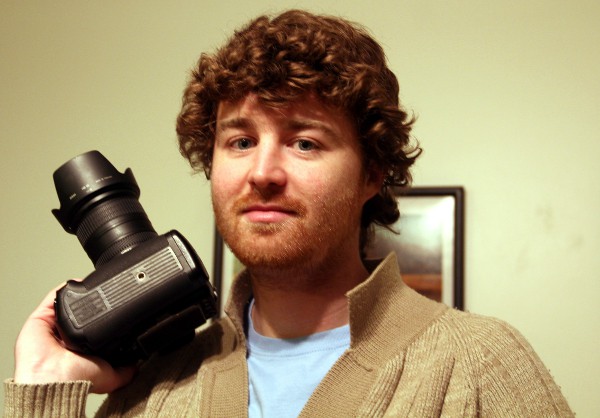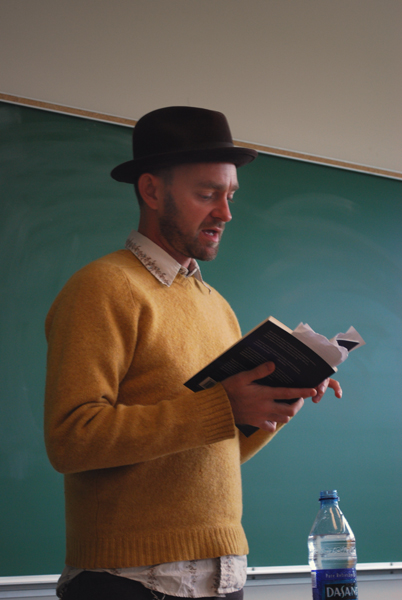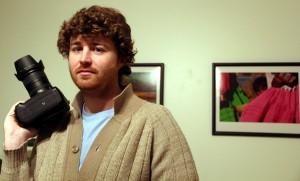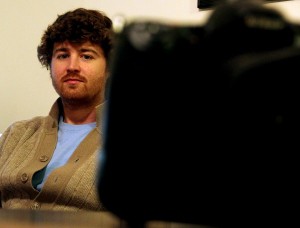Swapping the office for a more colourful picture
February 13, 2011 by Amanda Punshon · 2 Comments

Mark Feenstra quit his office job to pursue a career in fashion photography. (Photo by Sarah Casimong)
At first blush, it seems like something out of a Hollywood movie. Just over a year ago, Mark Feenstra quit his day job as an inventory analyst for Mountain Equipment Co-op in Vancouver to pursue more creative endeavours. If it were a movie, his decision would have been a spur-of-the-moment, dramatic impulse that caused his doting girlfriend no end of financial and emotional distress.
“It really wasn’t a last-minute decision or impulsive thing. There was definitely some soul-searching that went into that,” said Sarah Pawliuk, Feenstra’s girlfriend of two years. “I wasn’t freaked out that it was going to be a big disaster because he’s a really responsible and almost overly-thinking person.”
Feenstra described his position at MEC was a “stepping-stone job,” the kind of job people take when they’re looking to move up in the company.
“One day, I realized that I didn’t want to be where I was going next,” he said. “I loved everything about the company except what I was actually doing when I was sitting at my desk.” So he started making plans to leave the company. He saved money for over two years before he actually quit.
“I knew I needed to make a change while I was still young enough to do that easily. You can do it an any age, but I don’t have kids, I don’t have a mortgage. Now is a pretty good time to take on a high-risk endeavour.”
Feenstra said that he initially took time off to work on his writing. He went to Costa Rica for three months to surf and get himself into a “more creative headspace.”
When he came home, he realized that fiction writing wasn’t going to pay the bills. Even if he wrote the next great Canadian novel, found an agent and a publisher, it would still be at least two years before he earned any money.
“Rather than go back to work this year, like I had originally planned, I’ve decided to use that incredible, gripping fear of having to go back to an office to kind of push me into photography and trying to make a living at it,” he said.
Photography had been a passion of Feenstra’s for as long as he could remember. It was a hobby he shared with his mother, a cancer researcher-turned-biology teacher. He still has the nearly 30-year-old Nikon SLR camera he grew up using.
Feenstra is science-minded – another thing he inherited from his mother – and mechanics of operating a camera really appealed to him. “It’s kind of a way for me to approach more artistic endeavours but still have an element of control,” he said.
Another thing that appealed was the way photography forced Feenstra to step outside himself.
“I hate public speaking, I hate having to show up and meet strangers. Even just going to a party where I don’t know that many people, I get weird anxiety before I have to go. Yet I really want to shoot people. I like portraits, I want to do fashion photography, these are the things I want to do. And I’ve lately just been throwing myself into these scenarios where I don’t know anybody,” he said. “It always turns out to be these amazing experiences.”
Shyness isn’t the only thing Feenstra struggles with.
“One thing that still hasn’t gone away with writing or photography is just huge creative fear barriers. That kind of feeling that you’re not good enough, that you shouldn’t be doing this, that you don’t deserve it,” he said. “At the end of the day, the biggest challenge is just getting over my own inhibitions and just kind of feeling like I shouldn’t be doing this and doing it anyways. And getting through that every time has probably been the biggest challenge. Everything else, when it actually happens, is easy.”
But he sees the challenges as being an important part of the creative process.
“If you’re not a little bit scared of not pulling something off, then you have to question how worth doing it is,” Feenstra said. “If you’re trying to be creative and you’re trying to do something interesting or something that other people can interact with, then you have to be going out into at least your own unknown a little bit. Because if it’s just too easy, then why should anybody else be interested?”
Feenstra wants to break into fashion photography, in part because there are some fairly lucrative career opportunities in the industry, but also because it allows photographers to be creative.
“You flip through magazines, some of the stuff is just garish and awful, and you don’t know how anybody would publish something just so hideous and weird. But it’s great that that’s what somebody got to do,” he said.
He hopes to have his own studio one day, but his dreams are both bigger, and smaller, than that.
“I’d love to be ‘that guy’ in Vancouver where, when celebrities come through town, it’s like, ‘Oh, can we get Mark Feenstra to come in and shoot for the day?’ And I think it’s important to always keep that in mind and believe — act — as though that’s where you’re headed. I think it’s really important to pick a completely and seemingly unobtainable goal, and everything you do should build a foundation to get you in that direction,” he said.
Feenstra said he sees himself as being on the road to his dream, but he’s not hung up on achieving it as soon as possible.
“There’s a certain level of general fashion photography and editorial work that I’d be very happy with for a very long time. I don’t have to get up there, but that’s the general direction. And still, the really important thing for me to do is not get lost in that, and doing everything just commercial work.
“[I want] to pursue some of those personal creative projects without monetizing them,” Feenstra said. “If I want to take a couple months off to go shoot tribes in Borneo without trying to make a lot of money and be worrying who to sell that to, that would be a great place to be.”
Feenstra is not one of those people that’s putting himself all over the Internet in hopes of making a little money. But he is confident that he will eventually turn his passion into a lucrative career.
“If you have a good product, people will find you,” he says.
If you’d like to see samples of Feenstra’s work, you can visit his profile site at www.markfeenstra.com.
First poetic readings of semester show lively creative writing scene
October 2, 2009 by Kristi Jut · 1 Comment

Chris Hutchinson reads from his latest book "Other People's Lives," at the Surrey campus on Monday, Sept. 26. (Kristi Jut photo)
There’s much ado about the creative writing program at Kwantlen.
Though the first live poetry reading of the semester was attended by a modest group of 20-some students, the small crowd was lively and inquisitive on Monday, Sept. 28.
The reading featured noted B.C. poets Marguerite Pigeon and Chris Hutchinson, who came to speak with the students about the nature of writing.
Each read from their latest published works, featuring vastly different poetic styles, yet both agreed on the writing process as natural and instinctual.
Hutchinson, wearing a mustard-yellow sweater and wool cap, read from his poetry anthology “other people’s lives,†with a Ginsberg-esque drone and ‘60s-‘70s beat tonality.
“My process is very intuitive, I never know where a poem is going to take me,†he said.
Pigeon’s book “Inventory,†on the other hand, explored her relationships with inanimate objects, personifying, beautifully, their attributes.
The students had much to ask the established writers about the writing process, including their inspirations and their roadblocks.
“Resist!†Hutchinson laughed, addressing situations when being told the correct way to formulate poems.
But can creative writing really be taught? Kwantlen students wanted to know.
“It’s a funny thing to have writing in school because it puts two things that are at odds together,†Pigeon said. “It’s built like that [because] it pushes people through learning whether they like it or not and they come out a little more structured. But at the same time writing is not about following any structure, it’s very intuitive.â€
So where is the creative writing program going?
“The program is going towards integrating with the interdisciplinary arts,†said creative writing professor Matthew Rader. The program, which has already grown by over one-third in enrolment this year, has several possible outcomes.
“[Learning writing is important] because writing to start with is the primary negotiator in all disciplines and [excellence] is achieved by imagination in that skill,†said Rader.
Pigeon assured students that all people are writers, whether it be filling out surveys, chatting on facebook or sitting down to write some fiction.
Still, when it came to serious writing, some students said that they couldn’t help but be defensive about their work.
“The more you write,†Pigeon offered, “the less you care that one thing you wrote was bad.â€
Pigeon said she wanted to write her entire life, but didn’t think it would be realistic, so she was “a journalist instead.â€
“If you believe in writing,†she said, “it will save you.†That is the sentiment that Rader wanted to get across by having live readings in school.
“[I want] to show aspiring writers that professional writers exist,†he said. “There’s a chance that these people are like us and they’re right here.â€
According to Rader, there are five different possible futures for the creative writing students at Kwantlen, but at the moment it’s important for “people in university to be engaged in the community.â€
To keep in touch with the writing program at Kwantlen, follow them on Twitter or attend these readings:
- Oct. 22: Jan Conn, 1 p.m., Room D224, Surrey
- Oct. 28: Marilyn Simonds, 6 p.m., Room D144, Surrey
- Nov. 3: Sachiko Murakami, 2 p.m., Room D224, Surrey
- Dec. 29: Elizabeth Bachinsky/Open Mic, Time and location TBA




